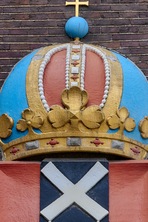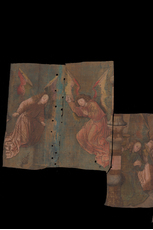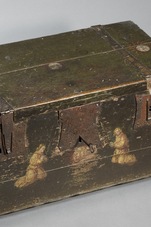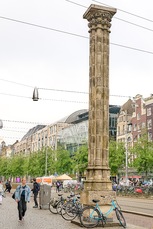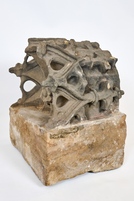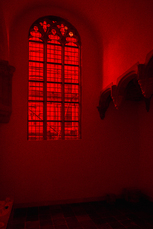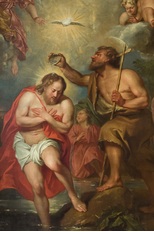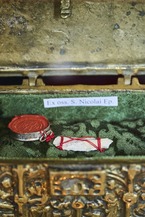1. Huis te Vraag
Rijnsburgstraat 51
One of the most famous figures who goes to Amsterdam for a pilgrimage is the Archduke and later Emperor Maximilian I, or so the stories go. Maximilian married Mary of Burgundy and became Count of Holland. When Maximilian was in bed in 1482 at his castle in The Hague with a severe fever, he promised to make a pilgrimage to the Miracle of Amsterdam if he was cured. Almost immediately, the fever disappears and, as promised, Maximilian makes the journey to the Chapel of the Holy City in gratitude for his recovery. He gives the Holy Stead a golden chalice, church windows and beautiful priestly robes. The city of Amsterdam was also given the right to add the imperial crown to the city's coat of arms.
Do you want to know more about the Crown Imperial?
The story goes that Maximilian approaches Amsterdam and asks for directions at the inn where Huis te Vraag is located until 1890. We should certainly cherish this beautiful story, but also take it with a grain of salt. Maximilian did visit Amsterdam, that part of the legend is correct. But the fact that he asked for directions at Huis te Vraag is probably a 19th-century myth, when people in Catholic circles liked to exaggerate legends. In 1884, Amsterdam received another visit from a legendary imperial traveller, the Habsburg Empress Sisi by marriage. She visits the Beguinage Chapel to commemorate the miraculous healing of Maximilian, 400 years earlier.
Huis te Vraag has been given varying functions over the past centuries and is currently a place of silence and park. If the gate is open, it is definitely worth walking in and enjoying the garden and the remains of the former cemetery. At the end of the 19th century, the site was set up as a cemetery of the Protestant Community of Sloten. The municipality buys and closes the cemetery in 1963. Approximately 12 thousand deceased people will have been buried there. Volunteers are currently maintaining the garden.
Can be visited from Tuesday - Friday between 11:00 and 17:00. (in winter until 16.00 hours).
2. Amstelveenseweg 136
In the 15th and 16th centuries, residents in Amsterdam, Haarlem and Leiden received a call from the town hall to take part in the Miracle Procession in March. Bell ringing calls on the people of Amsterdam to decorate their homes and erect altars of rest for the procession. From Haarlem, Leiden and elsewhere, pilgrims flock to Amsterdam. After a journey over dikes and water, they reach the Heiligeweg (the current Overtoom and Leidsestraat) via Sloten or Amstelveen. From the current Heiligeweg they walk the last kilometers to Amsterdam.
We walk along the Schinkelkade to the Amstelveenseweg, the former medieval dike over which Maximilian also entered the city. Until 1896 this road runs along the water of the Schinkel. It is the territory of the former municipality of Nieuwer-Amstel. Due to the many polders, the road has a rural character. The quay developed economically with inns and textile industry and until the 17th century was also the last resting and transfer point on the route from Rotterdam and Leiden to Amsterdam. The Amstelveen road was widened in the 19th century. This also shifts the water route and the quay of the Schinkel.
At Amstelveenseweg 136 we find the Schinkelkerk, a building of the Reformed Churches, which was in use from 1890 to 1975. It is the second church built in Amsterdam by architect Tjeerd Kuipers. The adjacent minister's house was built at the same time in the Eerste Schinkelstraat. In 1924, Reverend Johannes Geelkerken preached a sermon here that would lead to a split in the Reformed Churches. In the eyes of a brother, Geelkerken speaks too loosely about the talking serpent in the Bible book of Genesis. The pastor was fired after much hassle and started a new church federation with supporters in 1926: the Reformed Churches in Restored Association.
At number 134 is the pop hall OCCII, in a building built in 1883-'84 by architect Abraham Salm as a horse tram depot with stables. Together with his father, Salm also made the designs for the buildings that now house the Melkweg and Paradiso concert halls. The buildings were originally designed as a sugar factory and a church respectively.
3. Vondelpark, entrance
We cross the Amstelveense road to the Vondelpark and turn left in the park. Where the Vondelpark is now located, there used to be polders. Piet van Eeghen, merchant and benefactor, initiated the construction of the park together with others, just as he and a group of committed Amsterdammers were at the basis of the Prinsengracht hospital and the Stedelijk Museum. Van Eeghen provides a network of financiers and sets up the Association for the Construction of a Riding and Walking Park for the Vondelpark in the making. In 1864, the first part of the park opened. In the end, it took 12 years before the park was completely finished, entirely financed by private individuals. It was not until 1953 that the city bought the park from the association for 1 guilder.
4. Overtoom 517-555
We leave the park on the other side of the Vondelpark and continue on the Amstelveenseweg to the Overtoom. From 1892 to 1954 the Dutch Reformed Overtoom Church stood at the head of the Overtoom, built to the design of architect J. Wittebol. At the location, you can now see a modern-day brutalist temple; first for the car and now for the body. The Autopon complex bears the name of car importer Pon. The architects Commer de Geus and Ben Ingwersen designed the building. They use Le Corbusier's Unité d'Habitation, a residential complex in Marseille, as a source of inspiration. The architectural style is called brutalism and the complex curves along with the road. In addition to the modern showroom, the building has a garage for maintenance and a basement in which two hundred cars can be stored. Above the showroom, 56 apartments have been realized.
We are now walking on the Overtoom, a busy road, from the moment the pilgrims visit the city. This road is traditionally called the Heiligeweg (Holy road). The Overtoom was built in 1515 between the Schinkel and the Kostverlorenwetering. Despite the damping of the canal at the beginning of the 20th century, the name and the crowds have remained unchanged.
5. Hofje (Courtyard) de Eendracht
Overtoom 295
The Overtoom was not yet filled in in the 19th century. Sometimes you will find traces of the old times in which activities take place that do not fit within the Amsterdam city walls and jurisdiction: theatres (to circumvent the Schouwburg Monopoly), inns and beer breweries (to avoid the beer excise duty), but also dangerous or even polluting industry (powder mills, cotton printing works, vinegar or sulphuric acid factories).
In 1752, for example, on the site of the former Blankenburg pottery factory on the Overtoom, there was a French Theatre, also known as Theater Blankenburg. Due to the great popularity of the theatre, there is a real carriage ordinance to guide traffic when going out of a performance. After the French theatre burned down — and the Kleine Komedie aan de Amstel took its place — a beautiful country house was built on the Overtoom around 1776: Fort d'Eendragt. It has been used as a home for poor elderly people since 1791 with the name De Eendracht. Residents receive free butter, coffee, tea, meat, potatoes and other food. They also take religion lessons and have to keep their room tidy, otherwise they can leave. Until 1969 it was used as a home for the elderly and asylum, but then the building fell into disrepair and had to make way for a new building. Next to the place where De Eendracht once stood, the Eendracht-Anslohofje was built in 1970. House number 295 will also move with it. It's nice that an apartment building can also be a 'courtyard'. In 2002, the building was renovated and adapted to current housing standards. In the regent's room in the garden, the portraits of the founders, Jan van Mekeren and his third wife Johanna Bontekoning, still hang. This room was hardly ever used by the regents, but by the residents to eat together or to celebrate something.
6. Vondel Church
Vondelstraat 120
We walk into the Anna van den Vondelstraat and automatically run into the Vondel Church. In 1872, the first stone of this new Roman Catholic church in neo-Gothic style was laid. A year later, however, the money ran out and only two bays of the choir with apse were finished. With the help of a lottery of 'art, products and objects of taste', an amount of 45,000 guilders was raised in 1875 to finish the church. In 1880, the bishop of Haarlem consecrates the church of the Most Sacred Heart of Jesus, the official name of the Vondel Church.
Architect Pierre Cuypers designed the Vondel Church after a medieval model. The Gothic is his starting point, but he is also always looking for innovations, such as the steel construction for the tower. Cuypers groups the side chapels around a high tower, a characteristic that can be found in many of his church designs. After the church was decommissioned in 1977, the building was sold for one guilder to an investor who then did not look after it. As a result, the church quickly fell into disrepair and squatters moved in. To protect the building from demolition, the Vondelkerk Foundation was established in 1981. The redevelopment of the Vondelkerk is in many ways a breakthrough in thinking about the restoration and repurposing of churches and leads to the establishment of the Amsterdam Monument Fund.
7. Loge building Nos Vinxit Libertas
Vondelstraat 39-41
We pass the lodge building of the Freemasons of Amsterdam in the Vondelstraat at number 39-41. Freemasonry is practiced exclusively in lodges. This refers to medieval England, where the builders of cathedrals live and work in construction huts: lodges. Today's lodges are also called workshops. They are local associations that belong to the national Order of Freemasons. In 1905, the lodge 'Willem Fredrik' moved into this building, only to disappear temporarily 35 years later when the German occupying forces took the building into use during the Second World War. From that moment on, the brothers of Willem Fredrik continued under the pseudonym 'Wynand Fockink', after the famous liquor store and distillery. They meet during the war as a bowling club in the Parkhotel. After 1945, the members moved back into their building. Meanwhile, the lodge building, which was thoroughly overhauled in 2012, is a workshop for all Amsterdam lodges. Once a year, the building is open to non-members.
8. Heiligewegspoort (Holy Road Gate)
Between Heiligeweg and Koningsplein
At the end of the Vondelstraat, we approach the former entrance of the city of Amsterdam.
First we take a look at the site of the Marriott Hotel, where the domed church of the Dutch Reformed Church stands until 1972. On the other side of the church is the Heiligewegspoort from 1664. This gate is always at different locations in the city. As the city grows, the gate moves further and further outwards. The first Heiligewegspoort is at the end of the current Heiligeweg. After the first expansion of Amsterdam (1585), the gate was moved to the end of the Heiligeweg Burgwal, after reclamation nowadays known as the Koningsplein.
Initially, this gate was built in wood, but in 1637 the gate was replaced to a design by Jacob van Campen. Due to the fourth explanation of Amsterdam, the gate lies within the city walls. In 1664, the function of the gate was taken over by the Leidsepoort further south and the Heiligewegspoort was demolished. The Leidsepoort is part of the fortifications of Amsterdam and is located on the south side of the Leidseplein, opposite the current Marnixstraat. At the Leidsepoort, the Heiligewegse Vaart begins, the later Overtoomse Vaart. The current Amsterdam American Hotel stands approximately on the site of the gate that was demolished in 1862. With the arrival of the theatre in 1774, the Leidseplein became the centre of all the fuss and entertainment of the city.
9. Heiligeweg (Holy road)
We cross the Leidseplein and walk into the Leidsestraat. Remember that until the 17th century there is only a path to the Heilige Stede, the place where the Miracle of Amsterdam took place in 1345. The path was developed into Leidsestraat with the arrival of the Leidsepoort, so that a road leads from the new city gate to the city center. We walk further to the Heiligeweg. Nowadays, apart from this gate and the street name, there is little left that reminds us of the pilgrims who almost reached the Holy Stead after a long journey. A lot has changed since then. In the former monastery, the re-education of men took place from 1595 to 1896, in a so-called rasphuis. In 1896, the old Rasphuis was demolished to make way for the first indoor swimming pool in Amsterdam, the Heiligewegbad. Nowadays the Kalvertoren stands here.
10. Miracle of Amsterdam
Kalverstraat ca. 77
We turn left into the Kalverstraat and approach the place of the miracle. On the corner of the Kalverstraat and the Wijde Kapelsteeg we see a memorial stone in the façade. This corner is also called the holy corner, because the house of the sick man stood here. With him the story of the Miracle of Amsterdam begins in 1345. The man is dying and is administered the host by a priest. He can't keep them in. According to Catholic regulations, the vomit with the host is thrown into the burning hearth. The next morning, the man's nurse finds the intact host in the still burning fire. She has a priest come, who brings the host to the Oude Kerk. But, inexplicably, the host returns to the man's house. It soon becomes clear that this is a miracle. Not much later, when the church and the city council have recognized the miracle, the Holy Stead (holy place) is built. And pilgrims flock from far and wide.
Do you want to know more about the Holy Stead ?
Or about the Miracle of Amsterdam?
11. Miracle column
Rokin 78-80
When we walk into the Wijde Kapelsteeg towards the Rokin, we are in front of the Miracle Column, which is built from fragments of the Holy Stead. In 1578, the veneration of the Miracle in the Holy Stead came to an end. Amsterdam then got a Protestant administration that forbade all public expressions of the Catholic faith. The Holy Stead became a Protestant church and was called Nieuwezijds Chapel from that time on. Even though the building is now used for Protestant worship, for many Catholics the building is still the old Holy Stead for centuries. Unfortunately, in 1908, to the chagrin of many, it was demolished and replaced by a new church building: the new Nieuwezijds Chapel, built by architect Posthumus Meyers. Meanwhile, this building is no longer a church, but a popular tourist attraction where the dark sides of Amsterdam's history are brought to life.
The Miracle Column is a reminder of the Miracle and of the old Holy Stead. Artist Hans 't Mannetje built this column in 1988 from wandering building fragments.
More about the Miracle Column ...
Do you want to know more about the wanderings of the building fragments?
12. Silent Walk
Every year in March, the Silent Walk is a nocturnal tour through the city center, which follows the route of the medieval procession in honor of the Miracle of Amsterdam. The medieval route starts in Kalverstraat at the Holy Stead. Via the Dam and the Nieuwendijk, the procession continues to the Nieuwe Brug, where the ships are blessed to plead for safe navigation with the Most High. At that time, the water was still in open connection with the IJ and the sea. The procession then walks via the Warmoesstraat through the Nes and the Langebrugsteeg, over the Langebrug and through the Taksteeg back to the Kalverstraat, where they walk around the Heilige Stede three more times. Then the monstrance with the Miracle Host is carried inside and placed on the altar.
In 1880, the Amsterdammer Joseph Lousbergh discovered a document in which the medieval route was described in detail. Together with friend Carel Elsenburg, he started walking this route in 1881 in 'silent conversation'. Following this initiative, many join and even the Gezelschap van de Stille Omgang is founded. Now there is still a group of about 7000 participants who participate in the nightly silent march.
13. Oude Kerk (Old Church)
Oudekerksplein
We walk via the Rokin and the Warmoestraat to the Oude Kerk. For us, this is one of the nicest places in the city: to enjoy the empty church, great contemporary art, breathtakingly beautiful music, the occasional service on Sunday or just to be able to be. And it is the oldest building in the city with a rich building history. In the second half of the 13th century, the wooden chapel was replaced by a stone hall church. After 1300, the people of Amsterdam expanded the church in Romanesque style and you can read the history through the stones, not only in the niches and chapels, but also from the floor. The tombstones show a wide variety of people who are buried here: regent families with names such as Bicker, Six, van Beuningen and De Vlaming van Oudtshoorn, the composer Jan Pieterszoon Sweelinck and Jacob Matroos Beeldsnijder, as the only coloured person, and Saskia van Uylenburgh, Rembrandt's wife. Every year on March 9 at exactly eight past eight in the morning, the sun falls on Saskia's grave. You can look up more names and stones online via www.gravenopinternet.nl.
Our coffee tip can of course also be found here, in the donation shop attached to the church.
Do you want to know more about art in the Oude Kerk?
14. Ons’ Lieve Heer Op Solder (Our Lord in the Attic)
Oudezijds Voorburgwal 38-40
We are approaching the end point of this walk and walk to another absolute highlight in the city center. The Catholic clandestine church Our Lord in the Attic, built in 1662-63 by the German merchant Jan Hartman. As a result of the Alteration in 1578, Catholic mass was also forbidden in the Oude Kerk, just like in the Holy Stead. The church became Protestant and the Catholics had to seek refuge in the living rooms of fellow believers and later in clandestine churches in attics and warehouses. As long as there is nothing to see from the outside that resembles a Catholic church, the clandestine churches are tolerated by the city council.
In addition to the history, it is worth admiring the colors and stylish furnishings of the clandestine church. After the restoration and colour research, a beautiful 'world-of-interiors' was created.
Do you want to know more about the clandestine church?
15. Sint Nicolaas basiliek (Basilica of Saint Nicholas)
Prins Hendrikkade 73
If there is still energy in the legs, we will close at the church around the corner: the Basilica of Saint Nicholas. When the Catholics were allowed to build churches again in the 19th century, they left their old clandestine churches. For example, Our Lord in the Attic also becomes superfluous and a large visible church is built at the head of the Zeedijk, dedicated to Saint Nicholas, the patron saint of Amsterdam. In honor of the 750th anniversary of the city of Amsterdam, the basilica was named the first co-cathedral in Amsterdam by Pope Francis in 2025.
In the Basilica you can visit a relic of Saint Nicholas



